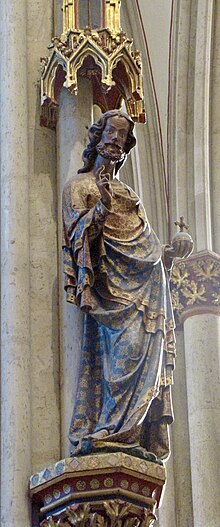John of Cologne (cathedral builder, 1270)
John of Cologne (* around 1270 in Cologne ; † March 15, 1331 ibid) was the third master builder at Cologne Cathedral . During his time, the choir was consecrated on September 27, 1322 .
Johannes was the son of the second Cologne cathedral builder Arnold . He was nicknamed "Poleyr" (or "Parlier") and was possibly the progenitor of the later famous master builder family, the Parler .
Johannes he probably worked as a journeyman in Freiburg and Strasbourg and was already working under his father at the Cologne cathedral builder around 1296 . Before 1308 he succeeded his father in the office of master builder of Cologne Cathedral . He was married to Megtildis von Sailecgin, with whom he had nine children.
During his tenure the high vault and the buttress were built . After completion of the high choir, Johannes undertook the construction of the southern transept, for the foundation of which the existing older vestibule had to be laid down in 1325 ( quam porticum propter novum iam fundamentum pro ecclesie nostre constructione penendum expedit demolire ). The corresponding parts of the Südquerhaues can be dated "in the time after 1325 to immediately after 1331", that is to say in the last years of Master Johannes. Under him the eastern parts of the now double-aisled south aisle were started. At times, the large plan of the west facade ( facade crack F ) was attributed to him by some researchers, but this has since been refuted.
According to the dating of Robert Suckale , however, the choir pillars were made between 1320 and 1340 and thus under the supervision of Johannes. The figures, which were described as “over-French” because of their mannered over-refinement, can be stylistically placed in a series of Parisian sculptural art, but without a close reference to a French model. The artists, who can be counted among the avant-garde in Germany, not only created more richly shaped garment facades that detached themselves from the body tucked underneath. These were also painted over with splendid, brightly colored and patterned textile ornaments and thus resulted in a "show effect of the silk fabrics."
This means that the pillars of the choir should not only be viewed as the climax of the Mannerist phase of Gothic sculpture. They are at the same time the beginning of the new, softer art of sculpture, which leads to the bohemian beautiful style , which was imitated all over Europe. “It should be taken more seriously that the Peter Parlers family , the artistic leaders of the second half of the century, were closely connected to the Cologne cathedral builder .” Peter Parler was probably the grandson of Johannes or his brother Rutger .
See also
literature
→ Main page: Bibliography on Cologne Cathedral (in the portal: Cologne Cathedral )
- Johann Jakob Merlo : Master Johann . In: Allgemeine Deutsche Biographie (ADB). Volume 14, Duncker & Humblot, Leipzig 1881, p. 460.
- Max Hasak : The cathedral of St. Peter in Cologne on the Rhine. Berlin 1911, pp. 83-98.
- Paul Clemen (Ed.): The Cologne Cathedral (= The Art Monuments of the Rhine Province . Volume 6, Part III). 2nd, increased edition, Schwann, Düsseldorf 1938 (reprint Düsseldorf Schwann 1980), ISBN 3-590-32101-6 ), p. 60.
- Herbert Rode: Johannes. In: New German Biography (NDB). Volume 10, Duncker & Humblot, Berlin 1974, ISBN 3-428-00191-5 , pp. 557 f. ( Digitized version ).
- Ingrid Münch: Johannes of Cologne. In: Biographisch-Bibliographisches Kirchenlexikon (BBKL). Volume 3, Bautz, Herzberg 1992, ISBN 3-88309-035-2 , Sp. 886-888.
Individual evidence
- ↑ Andreas Huppertz: The Art Family of the Parler and the Cologne Cathedral, in: Hans Vogts (ed.): The Cologne Cathedral, Festschrift for the Seven Centennial Celebration 1248–1948, Cologne 1948, p. 142
- ^ Paul Clemen: The Cologne Cathedral (= The Art Monuments of the Rhine Province, VI, III. Department: The Art Monuments of the City of Cologne , Volume I). Düsseldorf, 1937, p. 60.
- ↑ Marc Steinmann: Thoughts on the Gothic transept of Cologne Cathedral. In: Kölner Domblatt, Vol. 72, 2007, p. 137.
- ^ Adolf Klein: The Cologne Cathedral. The eventful history of its completion . Cologne 1980, p. 27. Other dates of the plan from Marc Steinmann: The west facade of Cologne Cathedral. The medieval facade plan F (research on Cologne Cathedral 1), Cologne, Verlag Kölner Dom, 2004. ISBN 978-3-922442-50-9 (around 1270/80) and Johann Josef Böker u. a .: Gothic architecture. The Rhineland. An inventory catalog of medieval architectural drawings. Müry & Salzmann, Salzburg, 2013, No. 129. ISBN 978-3-99014-064-2 (around 1360) and above all Johann Josef Böker: Michael von Savoyen and the crack of the facade of the Cologne Cathedral, Cologne 2018.
- ↑ Georg Dehio: History of German Art, Vol. 2. The late Middle Ages from Rudolf von Habsburg to Maximilian I. The Art of the Gothic, Berlin 1930, p. 95f
- ^ Robert Suckale: Dating questions are questions of understanding, on the classification of the Cologne cathedral choir statues, in: Klaus Hardering (ed.): Die Chorpfeilerfiguren des Kölner Domes, Kölner Domblatt 2012, p. 281ff
- ↑ Robert Suckale: Dating questions are questions of understanding, on the classification of the Cologne cathedral choir statues, in: Klaus Hardering (ed.): Die Chorpfeilerfiguren des Kölner Domes, Kölner Domblatt 2012, p. 284
- ↑ Robert Suckale: Dating questions are questions of understanding, on the classification of the Cologne cathedral choir statues, in: Klaus Hardering (ed.): Die Chorpfeilerfiguren des Kölner Domes, Kölner Domblatt 2012, p. 284
- ^ Johann Josef Böker: Michael von Savoyen and the facade crack of the Cologne Cathedral, Cologne 2018, p. 95
| personal data | |
|---|---|
| SURNAME | John of Cologne |
| BRIEF DESCRIPTION | medieval cathedral builder in Cologne |
| DATE OF BIRTH | around 1270 |
| PLACE OF BIRTH | Cologne |
| DATE OF DEATH | March 15, 1331 |
| Place of death | Cologne |

